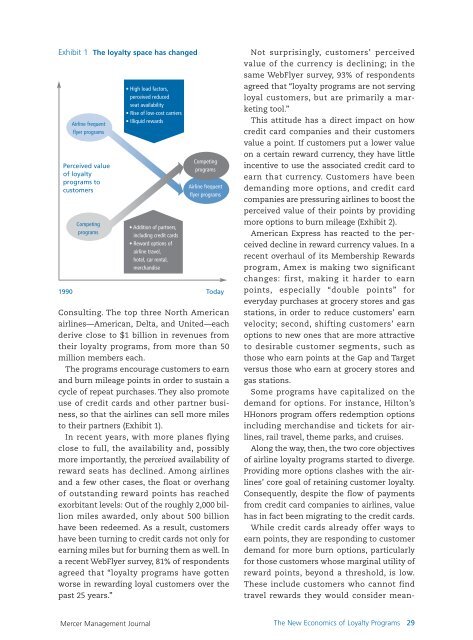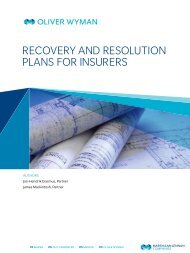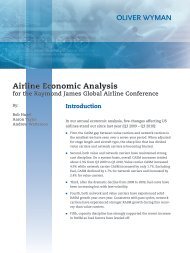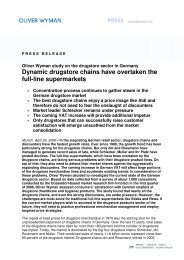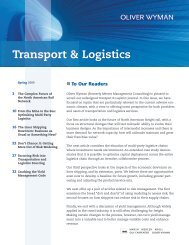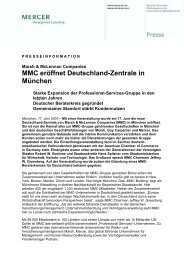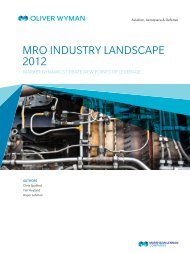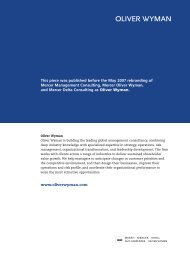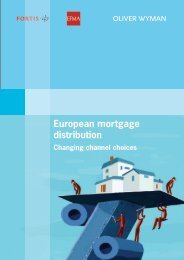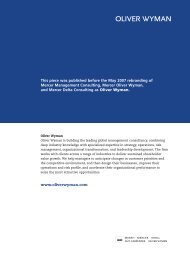The New Economics of Loyalty Programs Customers ... - Oliver Wyman
The New Economics of Loyalty Programs Customers ... - Oliver Wyman
The New Economics of Loyalty Programs Customers ... - Oliver Wyman
You also want an ePaper? Increase the reach of your titles
YUMPU automatically turns print PDFs into web optimized ePapers that Google loves.
Exhibit 1 <strong>The</strong> loyalty space has changed<br />
Airline frequent<br />
flyer programs<br />
Perceived value<br />
<strong>of</strong> loyalty<br />
programs to<br />
customers<br />
Competing<br />
programs<br />
1990 Today<br />
Consulting. <strong>The</strong> top three North American<br />
airlines—American, Delta, and United—each<br />
derive close to $1 billion in revenues from<br />
their loyalty programs, from more than 50<br />
million members each.<br />
<strong>The</strong> programs encourage customers to earn<br />
and burn mileage points in order to sustain a<br />
cycle <strong>of</strong> repeat purchases. <strong>The</strong>y also promote<br />
use <strong>of</strong> credit cards and other partner business,<br />
so that the airlines can sell more miles<br />
to their partners (Exhibit 1).<br />
In recent years, with more planes flying<br />
close to full, the availability and, possibly<br />
more importantly, the perceived availability <strong>of</strong><br />
reward seats has declined. Among airlines<br />
and a few other cases, the float or overhang<br />
<strong>of</strong> outstanding reward points has reached<br />
exorbitant levels: Out <strong>of</strong> the roughly 2,000 billion<br />
miles awarded, only about 500 billion<br />
have been redeemed. As a result, customers<br />
have been turning to credit cards not only for<br />
earning miles but for burning them as well. In<br />
a recent WebFlyer survey, 81% <strong>of</strong> respondents<br />
agreed that “loyalty programs have gotten<br />
worse in rewarding loyal customers over the<br />
past 25 years.”<br />
Mercer Management Journal<br />
High load factors,<br />
perceived reduced<br />
seat availability<br />
Rise <strong>of</strong> low-cost carriers<br />
Illiquid rewards<br />
Addition <strong>of</strong> partners,<br />
including credit cards<br />
Reward options <strong>of</strong><br />
airline travel,<br />
hotel, car rental,<br />
merchandise<br />
Competing<br />
programs<br />
Airline frequent<br />
flyer programs<br />
Not surprisingly, customers’ perceived<br />
value <strong>of</strong> the currency is declining; in the<br />
same WebFlyer survey, 93% <strong>of</strong> respondents<br />
agreed that “loyalty programs are not serving<br />
loyal customers, but are primarily a marketing<br />
tool.”<br />
This attitude has a direct impact on how<br />
credit card companies and their customers<br />
value a point. If customers put a lower value<br />
on a certain reward currency, they have little<br />
incentive to use the associated credit card to<br />
earn that currency. <strong>Customers</strong> have been<br />
demanding more options, and credit card<br />
companies are pressuring airlines to boost the<br />
perceived value <strong>of</strong> their points by providing<br />
more options to burn mileage (Exhibit 2).<br />
American Express has reacted to the perceived<br />
decline in reward currency values. In a<br />
recent overhaul <strong>of</strong> its Membership Rewards<br />
program, Amex is making two significant<br />
changes: first, making it harder to earn<br />
points, especially “double points” for<br />
everyday purchases at grocery stores and gas<br />
stations, in order to reduce customers’ earn<br />
velocity; second, shifting customers’ earn<br />
options to new ones that are more attractive<br />
to desirable customer segments, such as<br />
those who earn points at the Gap and Target<br />
versus those who earn at grocery stores and<br />
gas stations.<br />
Some programs have capitalized on the<br />
demand for options. For instance, Hilton’s<br />
HHonors program <strong>of</strong>fers redemption options<br />
including merchandise and tickets for airlines,<br />
rail travel, theme parks, and cruises.<br />
Along the way, then, the two core objectives<br />
<strong>of</strong> airline loyalty programs started to diverge.<br />
Providing more options clashes with the airlines’<br />
core goal <strong>of</strong> retaining customer loyalty.<br />
Consequently, despite the flow <strong>of</strong> payments<br />
from credit card companies to airlines, value<br />
has in fact been migrating to the credit cards.<br />
While credit cards already <strong>of</strong>fer ways to<br />
earn points, they are responding to customer<br />
demand for more burn options, particularly<br />
for those customers whose marginal utility <strong>of</strong><br />
reward points, beyond a threshold, is low.<br />
<strong>The</strong>se include customers who cannot find<br />
travel rewards they would consider mean-<br />
<strong>The</strong> <strong>New</strong> <strong>Economics</strong> <strong>of</strong> <strong>Loyalty</strong> <strong>Programs</strong> 29


